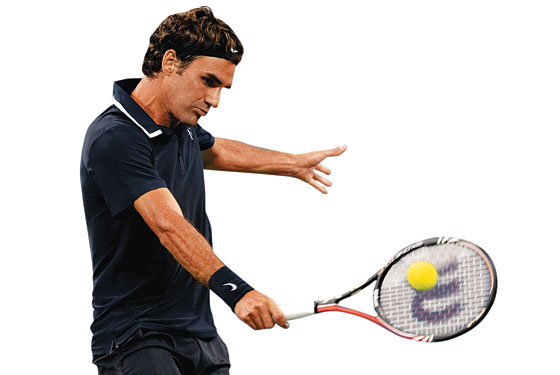
Probably the prettiest shot to watch in tennis is the one-handed backhand: Roger Federer and Justine Henin and a few others make it look so easy, obscuring the work that goes into getting both feet planted, timing the swing to catch the bounce, and blasting away at the ball with a balletic swat that can be expressive, elegant, and seductive.
“If you can hit a one-hander, it’s just art,” says Junior Ore, an 18-year-old who lost at the U.S. Open last week.
“It just flows,” agrees Daniel Kosakowski, another 18-year-old junior.
But over the years, the number of pros and juniors using the one-hander has steadily diminished. As the technology of strings and racquets improves and the game is played at faster speeds, the virtuosic one-y is on the not-so-slow road to extinction. In the top ten, only one female (Francesca Schiavone) and one male (Federer) play it. True, others on the tour have mastered it (Stanislas Wawrinka, James Blake, Mikhail Youzhny), but at the lower levels of the game, few coaches bother teaching it anymore.
“I’d say that 95 percent of juniors use two hands and 5 percent use one-y’s, maybe less,” says Ore.
“Everyone learns with two hands,” Kosakowski says.
After all, the two-hander has some instant advantages. Young kids can generate more power with two hands on the racquet. The shot is also easier to control and thus less frustrating for kids, who coaches fear may sour on tennis after flubbing so many balls. And with all the modern distractions at home, what kid has the patience to learn a more complicated stroke that doesn’t make his game better right away?
There are strategic advantages to the one-y. It’s easier to chase down balls holding the racquet with one hand. Plus the grip makes it easier to charge the net. Before they turned pro, serve-and-volley masters Pete Sampras and Stefan Edberg both switched to one-y’s. But with players now serving in the 130 mph–to–140 mph range, it’s easier to return a shot with another hand on the racquet. And because the returns are coming back faster, even the best servers are reluctant to charge the net for fear of getting passed.
Ore and Kosakowski both started out with two hands, but switched at age 13. Ore wanted to conserve energy. “You don’t have to muscle the ball,” he says. Kosakowski’s older brother Marcin had a one-hander he admired and wanted it as his own: “It’s just elegant.”
But choosing style over substance can become even the best player’s weakness. What can Federer do to defend Nadal’s smashing topspin approaches that bounce over his head, other than hit a feathery slice? A two-hander can take a big swing and hit down on the ball, flat and with power. The one-hander is a gorgeous anachronism in Federer’s game.
Realizing the two-hand backhand’s advantages, Federer has pondered switching from one to two. “I’ve tried it, in practice,” Federer told me at last year’s Open. He couldn’t figure it out. “I just don’t know what to do with my other hand.”
It figures that another great practitioner of this picturesque refinement is French. Richard Gasquet is one of the hardest players on the tour to like because of his Gallic peccadilloes: He sneers at ball boys that get in his way after bad shots; he complains that towels he’s given to cool down aren’t cold enough; he won’t play until everybody in the stands has taken a seat. And he can’t seem to win the big matches. But his one-hander is timelessly beautiful, a deadly arabesque sending balls blasting into the corners.
Gasquet talks about the poetry of his one-y like a snooty painter. “I think it’s more pleasing, more beautiful for the people to watch,” he told me before getting beat by fellow Frenchman Gael Monfils—who’s got a solid, if not exactly beautiful, two-hander.
Have good intel? Send tips to [email protected].